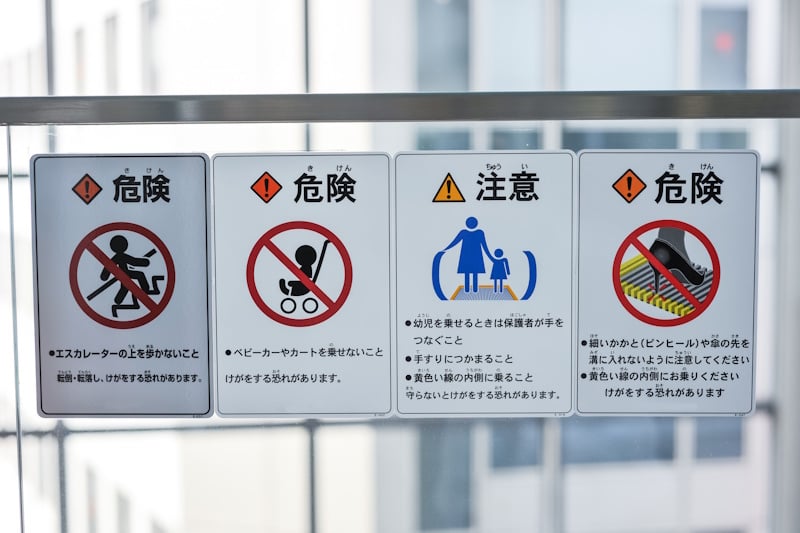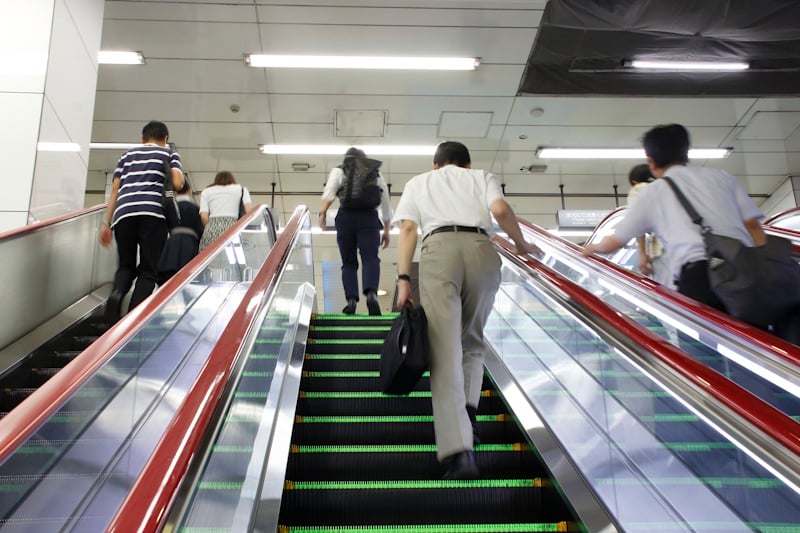For years, cities across Japan have tried to get people out of a bad habit: leaving one side of the escalator open for people in a hurry. It’s been an uphill climb. Even when surrounded by messages to change their behavior, most people ignore the new signs and default to old habits. However, recent experiences in Nagoya and at Osaka Expo provide hope that, one day, all of Japan may ride in two uniform lines up both sides of the escalator.
The quandary of which side to leave open
For decades, there’s been a convention in Japanese cities: one side of the escalator is reserved for people standing, while the other side is reserved for people running like bats out of hell.
The question is: which side is which?
The vexing answer is that it depends on where you are in Japan. For 80% of the country, if you stand on the left side of the escalator, you’re doing it right. I mean, left, I mean…you get what I mean.
However, there are a few prefectures where standing on the right is the rule. Many of these are in the Kansai or Kyushu regions and include Osaka, Hyogo, Nara, Wakayama, and Fukui Prefectures – a total of nine prefectures.
A pitched battle to stand on both sides
 A series of escalator safety signs. The leftmost sign urges people not to walk on escalators as it can lead to falls or injuries. (Picture: hiro / PIXTA(ピクスタ))
A series of escalator safety signs. The leftmost sign urges people not to walk on escalators as it can lead to falls or injuries. (Picture: hiro / PIXTA(ピクスタ))
In recent years, however, there’s been a push to get people to stand on both sides of the escalator and eliminate walking. Partly, this is motivated by studies showing that standing on both sides of the escalator can result in up to a 27% increase in capacity. Other studies have shown the majority of people – around 75% – prefer standing on escalators, which means keeping one lane clear for walkers is wasteful.
In Japan, safety is also a concern. Escalator users have complained of walkers knocking into them or even knocking them down. As Japan’s society ages, there are more people who can’t firmly grab the safety railing to maintain their balance as people pass by.
That’s led many cities and prefectures to try to convince people to stand on both sides. It hasn’t caught on in most locations, though. Saitama started experimenting with it in 2022. After a year, however, it found people reverting to old behaviors.
Nagoya’s winning strategy
However, according to LiveDoor News, there have been some wins for the “both sides” crowd lately.
The city of Nagoya decided in 2023 to move to a two-lane standing system for safety reasons. Besides simply putting up posters, it worked with railway companies and local media to draw awareness to the change.
Planning a trip to Japan? Get an authentic, interpreted experience from Unseen Japan Tours and see a side of the country others miss!

“Noah [at Unseen Japan] put together an itinerary that didn’t lock us in and we could travel at our own pace. In Tokyo, he guided us personally on a walking tour. Overall, he made our Japan trip an experience not to forget.” – Kate and Simon S., Australia

See a side of Tokyo that other tourists can’t. Book a tour with Unseen Japan Tours – we’ll tailor your trip to your interests and guide you through experiences usually closed off to non-Japanese speakers.


Want more news and views from Japan? Donate $5/month ($60 one-time donation) to the Unseen Japan Journalism Fund to join Unseen Japan Insider. You’ll get our Insider newsletter with more news and deep dives, a chance to get your burning Japan questions answered, and a voice in our future editorial direction.
As a result, many people who’ve recently visited Nagoya have taken to social media to praise the city for the transformation.
“Tokyo and Osaka could never,” one huffed. “It’s much safer,” another marveled.
Osaka Expo reverses the standard it set in 1970
 Picture: tarousite / PIXTA(ピクスタ)
Picture: tarousite / PIXTA(ピクスタ)
Osaka Expo has also instituted a two-lane standing rule for the escalators at the event. This is ironic because it was the 1970 Osaka Expo that set the standard for leaving one lane open for rapid travel.
“We should regard the one-lane-open escalator as a keepsake of an intolerant age,” one expert said. “I’d be happy if the Expo sparked a trend.”
This news earned a glowing review from outspoken musician and possible actual vampire GACKT, who showed that even a stopped clock can be right twice a day.
“Feels like our escalator riding habits, which I’ve always thought were dangerous, are finally changing,” he wrote.
Sources
東京の“常識”が、名古屋の“非常識”に? エスカレーターマナーを変えた名古屋市に賛同の声「浸透していてすごい」. LiveDoor News
片側空け、万博を機に消滅なるか エスカレーター、会場で2列定着. Kyodo News
「歩かないで、両側に立つべき」が多数派なのに…「エスカレーターの片側空け」が終わらない根本原因. President Online
エスカレーターで立つのは左? 右? 「左に立つ」人の多い都道府県が8割という結果に. YouPouch
Is It More Efficient to Stand or Walk on an Escalator? This Scientist Has The Answer. Science Alert


AloJapan.com